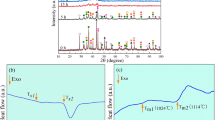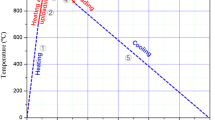Abstract
To investigate the microwave effect on the WC–Co alloys, WC–8 wt% Co alloy was fabricated by microwave sintering (MWS) in this paper. The results show that decarburization layer forms on the surface of the microwave-sintered samples. WC grain coarsening in the core area is strongly suppressed by the decarburization effect. In addition, the microstructure of the MWS-fabricated alloy was compared to that of the alloy sintered by vacuum sintering (VS). Microstructural investigations by transmission electron microscopy (TEM) and energy dispersive spectroscopy (EDS) show that more tungsten (29.50 wt%) is dissolved in the cobalt binder phase in microwave-sintered alloy than that in the vacuum-sintered samples. Finally, the formation mechanism of the surface layer by skin effect was discussed.






Similar content being viewed by others
References
Wu X, Guo ZM, Wang HB, Song XY. Mechanical properties of WC–Co coatings with different decarburization levels. Rare Met. 2014;33(3):313.
Shon IJ, Kim BR, Doh JM, Yoon JK, Woo KD. Properties and rapid consolidation of ultra-hard tungsten carbide. J Alloys Compd. 2010;489(1):L4.
Fang ZZ, Wang X, Ryu T, Hwang KS, Sohn HY. Synthesis, sintering, and mechanical properties of nanocrystalline cemented tungsten carbide: a review. Int J Refract Metal Hard Mater. 2009;27(2):288.
Zhao S, Song X, Wang M, Wei C, Zhang J, Liu X. Matching of particle sizes of WC/Co powders and spark plasma sintering densification. Acta Metall Sin. 2009;45(4):497.
Chaim R, Levin M, Shlayer A, Estournes C. Sintering and densification of nanocrystalline ceramic oxide powders: a review. Adv Appl Ceram. 2008;107(3):159.
Luo JM, Xu JL, Zhong ZC. Microstructure and properties of Y2O3-doped steel-cemented WC prepared by microwave sintering. Rare Metels. 2013;32(5):496.
Bao R, Yi J. Densification and alloying of microwave sintering WC–8 wt% Co composites. Int J Refract Metal Hard Mater. 2014;43:269.
Roy R, Agarwal D, Cheng J, Gedevanishvili S. Full sintering of powdered-metal bodies in a microwave field. Nature. 1999;399(6737):668.
Luo SD, Yan M, Schaffer GB, Qian M. Sintering of titanium in vacuum by microwave radiation. Metall Mater Trans A Phys Metall Mater Sci. 2011;42A(8):2466.
Demirskyi D, Agrawal D, Ragulya A. Neck growth kinetics during microwave sintering of copper. Scripta Mater. 2010;62(8):552.
Annamalai R, Upadhyaya A, Agrawal D. An investigation on microwave sintering of Fe, Fe–Cu and Fe–Cu–C alloys. Bull Mater Sci. 2013;36(3):447.
Zhou C, Yi J, Luo S. Sintering high tungsten content W–Ni–Fe heavy alloys by microwave radiation. Metall Mater Trans A. 2014;45(1):455.
Demirskyi D, Ragulya A, Agrawal D. Initial stage sintering of binderless tungsten carbide powder under microwave radiation. Ceram Int. 2011;37(2):505.
Bao R, Yi J, Zhang H. A research on WC–8 Co preparation by microwave sintering. Int J Refract Metal Hard Mater. 2012;32:16.
Das S, Mukhopadhyay AK, Datta S. Prospects of microwave processing: an overview. Bull Mater Sci. 2009;32(1):1.
Bonache V, Salvador MD, Rocha VG, Borrell A. Microstructural control of ultrafine and nanocrystalline WC–12Co–VC/Cr3C2 mixture by spark plasma sintering. Ceram Int. 2011;37(3):1139.
Breval E, Cheng J, Agrawal D, Gigl P, Dennis M, Roy R, Papworth AJ. Comparison between microwave and conventional sintering of WC/Co composites. Mater Sci Eng A. 2005;391(1–2):285.
Sunil BR, Sivaprahasam D, Subasri R. Microwave sintering of nanocrystalline WC–12Co: challenges and perspectives. Int J Refract Metal Hard Mater. 2010;28(2):180.
Konyashin I, Hlawatschek S, Ries B, Lachmann F, Dorn F, Sologubenko A, Weirich T. On the mechanism of WC coarsening in WC–Co hardmetals with various carbon contents. Int J Refract Metal Hard Mater. 2009;27(2):234.
German RM. Liquid Phase Sintering. New York: Plenum Press; 1986. 168.
Bykov YV, Rybakov KI, Semenov VE. High-temperature microwave processing of materials. J Phys D Appl Phys. 2001;34(13):R55.
Ro K, Dreyer K, Gerdes T, Willert-Porada M. Microwave sintering of hardmetals. Int J Refract Metal Hard Mater. 1998;16(4):409.
Acknowledgments
This study was financially supported by the National Natural Science Foundation of China (No. 51274107).
Author information
Authors and Affiliations
Corresponding author
Rights and permissions
About this article
Cite this article
Bao, R., Yi, JH., Peng, YD. et al. Skin effect of WC–8 wt% Co alloy by microwave sintering. Rare Met. 41, 1364–1368 (2022). https://doi.org/10.1007/s12598-015-0488-3
Received:
Revised:
Accepted:
Published:
Issue Date:
DOI: https://doi.org/10.1007/s12598-015-0488-3




